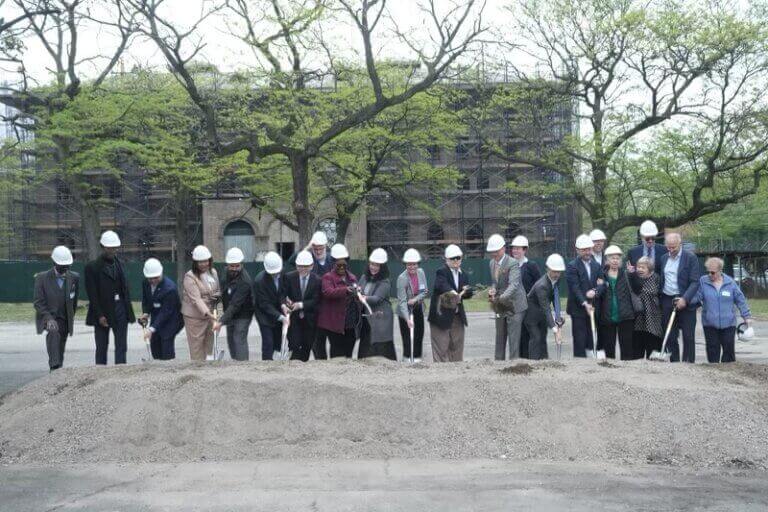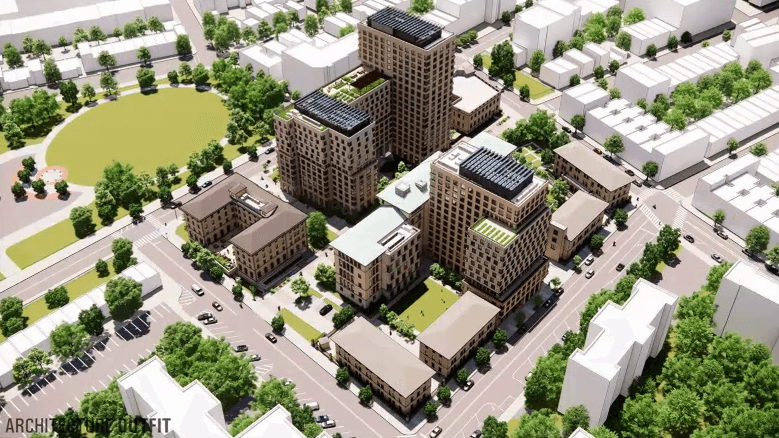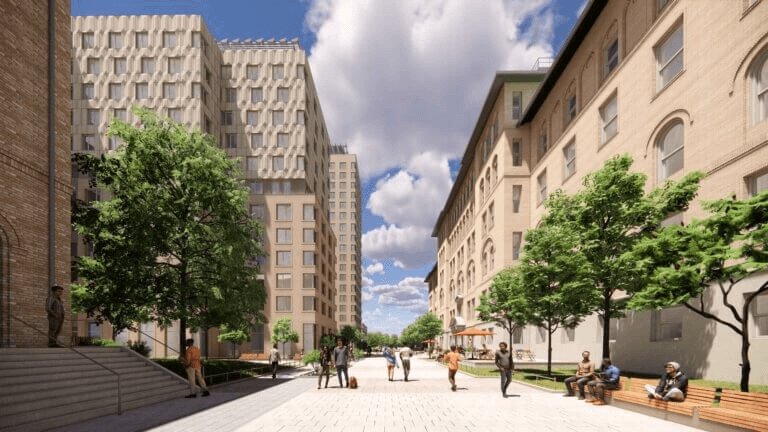Work Begins on Men's Shelter at Former Greenpoint Hospital Site
A new 200-bed men’s shelter is in the works on the site of the old Greenpoint Hospital in East Williamsburg.

A new shelter is being built at the site of the old Greenpoint Hospital in East Williamsburg. Rendering via ESKW Architects/Architectural Outfit
A new 200-bed men’s shelter is in the works on the site of the old Greenpoint Hospital in East Williamsburg.
Construction began on the Barbara Kleinman Men’s Shelter on Wednesday, marking the start of the development of Kingsland Common — a mixed-use development that will finally give the long-abandoned complex a new life.
The shelter will replace the old Barbara Kleinman Residence on Skillman Avenue.
For decades, a coalition of locals, known as the Greenpoint Renaissance Enterprise Corporation (GREC) have fought to bring a high-quality shelter and affordable housing to the nabe after the hospital closed in 1982.
“My husband Guido and I, along with my neighbors at GREC, devoted 40 years of our lives to redeveloping the campus,” said Theresa Cianciotta, of Concerned Citizens of Withers Street and GREC. “We were there for a 40-night vigil to ‘right size’ the former 1,150 bed shelter, attended every community board meeting to advocate, and invested countless hours with my neighbors to shape the plan for the campus.”

Project Renewal, St. Nicks Alliance and The Hudson Companies are working together alongside the city to build the new shelter, which will be housed inside the old Nurse’s Residence on Debevoise Avenue. The historic building will be gut-renovated to make way for the 54,000-square-foot facility.
Men’s shelter services provide a pathway to permanent housing
After construction wraps in December 2025, Project Renewal will provide services including employment counseling, occupational therapy, and medical and mental health care.
Those services will help the men staying at the shelter transition out to permanent housing, said Project Renewal CEO Eric Rosenbaum. Most shelter residents either move to a permanent supportive housing development with help from the Department of Social Services or receive vouchers to move into an affordable apartment.
Case managers will work with shelter residents to create Independent Living Plans, which help chart their path out of the shelter.
“That’s a joint process between the shelter client and their case manager to figure out what’s the pathway out of shelter for that particular person,” Rosenbaum said. “Each person’s circumstances are different, and also each person’s aspirations are different.”
Occupational therapy is a “bridge” to those aspirations for many people, Rosenbaum said, and helps people learn day-to-day life skills — budgeting, shopping, setting an alarm for work.

“We find this is hugely important because a lot of people get signed up for job training but then they don’t show up, or they don’t show up consistently, or they’re not wearing proper clothes for an interview,” he said. “Occupational therapy is one of the key services.”
Project Renewal also just received funding for peer counselors, Rosenbaum said — people with real life experience with homelessness and substance use who will work to connect with residents and help them choose the right substance abuse or harm reduction program.
It used to be that people living in shelters had to be out during the day, Rosenbaum said, but that’s not the case anymore. There is an 11 p.m. curfew, though.
“If you don’t sign in for your bed … you stay inside the shelter, but you’ll sit in a waiting area until either your bed is reassigned to you or you might get transferred to a different shelter,” he explained. “Because the system is so filled that they can’t just leave beds waiting for people who may or may not show up.”
The average stay at Project Renewal’s seven existing shelters is about a year and a half. Part of that time is dedicated to preparing the person to find their own place and move out, Rosenbaum said.
“Sadly, a lot of that time is just waiting for housing, because of the housing shortage,” he said. “That length of time has been increasing pretty steadily for at least a decade.”
Affordable housing, open space planned for Kingsland Commons
St. Nicks Alliance has been part of the redevelopment since the start — the organization was part of GREC, helped to create the current plan for Kingsland Commons, and facilitated communication with the local community regarding the shelter, said Deputy Executive Director for Housing Frank Lang.
By and large, the community understands the need for a quality shelter with good services in the nabe, Lang said, and has also been supportive of the redevelopment at large.
“This community has seen some of the most aggressive development of market-rate housing in the city over the last 15 years,” Lang said. “Being able to add 557 apartments that are focused exclusively on low-income households is tremendous. And that it would be designed in a way that’s bringing other accommodations and open space and other things, it kind of brings back a part of the neighborhood that has been kind of an obstacle.”
The finished Kingsland Commons will include retail stores, a café, public open spaces, a health center, and more. St. Nicks and Hudson Companies will be collaborating to make about $500,000 worth of improvements at Cooper Park across the street, Lang said, as well as a $1 million renovation of the nearby School Settlement project.
Broadway Builders, the project’s contractor, has agreed to support St. Nicks workforce development program and hire graduates of their construction program to work on the different phases of the redevelopment.
City struggles to house increasing homeless population
The old Barbara Kleinman Residence — which also has 200 beds — will stay open until the new shelter is finished. DHS is responsible for coordinating moves and referrals, a Project Renewal spox said, so it’s possible that residents will shift right into the new space or be moved elsewhere, depending on the shelter system’s capacity come 2025.
New York City’s homeless population has spiked over the last few years. According to the most recently-available data, 75,735 people slept in city shelters on the night of April 25, including nearly 18,000 single men. Those numbers don’t include people who are homeless who slept outdoors.
Brooklyn Community Board 1 – which includes Williamsburg and Greenpoint — is home to nine shelters in total, according to city data, with a combined census of 1,471 as of March 31, 2023. Most were single adults.

Roughly 255 people staying in shelters that day reported that they had most recently lived in CB1 before becoming homeless.
In 2017, then-mayor Bill de Blasio announced that the city needed to open 90 new shelters, and planned to open them in nabes with high rates of homelessness so people could stay close to their homes, schools, and jobs.
At the same time, the city council was working to overhaul the Fair Share law to redistribute public facilities more equitably throughout the city, including in wealthier neighborhoods.
Low-income areas often have disproportionately high numbers of shelters — Brooklyn Community Board 16 in Ocean Hill and Brownsville has 27, including nine hotel shelters, according to DHS data, with a population of more than 4,000. About 809 people in the shelter system citywide hail from CB16.
Shelters placed in desirable areas with good public transit and easy access to services are more likely to be successful than those placed in far-flung nabes, Rosenbaum said, and may attract people resistant to enter shelters.
When the city established the DHS in 1993, it was an “emergency response,” he explained. The city opened shelters wherever there was space, and with capacity needs expanding, it’s difficult to outfit buildings that were built for different purposes as shelters.
“The shelters that are being built today are being built thoughtfully, they’re designed for the purpose they’re serving,” he said. “It’s a pretty major step forward to making shelter more attractive and appealing so people are willing to come off the streets and live in them, and more functional.”
Editor’s note: A version of this story originally ran in Brooklyn Paper. Click here to see the original story.
Related Stories
- Long-Awaited Greenpoint Hospital Affordable Redevelopment Gets More Details, New Look
- City Picks Hudson to Develop Long-Stalled Greenpoint Hospital Site in East Williamsburg
- Greenpoint Hospital Development Plans Put on Hold
Email tips@brownstoner.com with further comments, questions or tips. Follow Brownstoner on Twitter and Instagram, and like us on Facebook.









What's Your Take? Leave a Comment